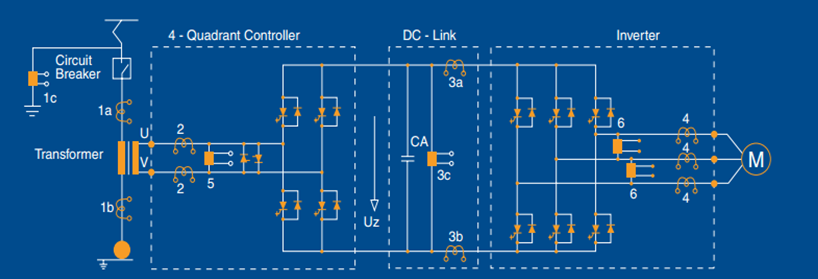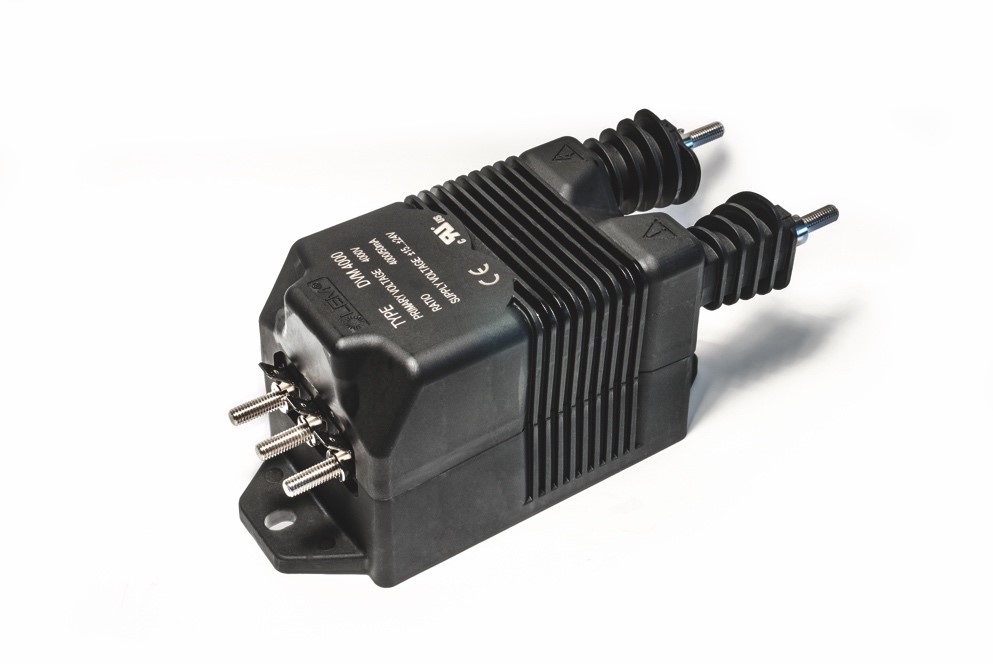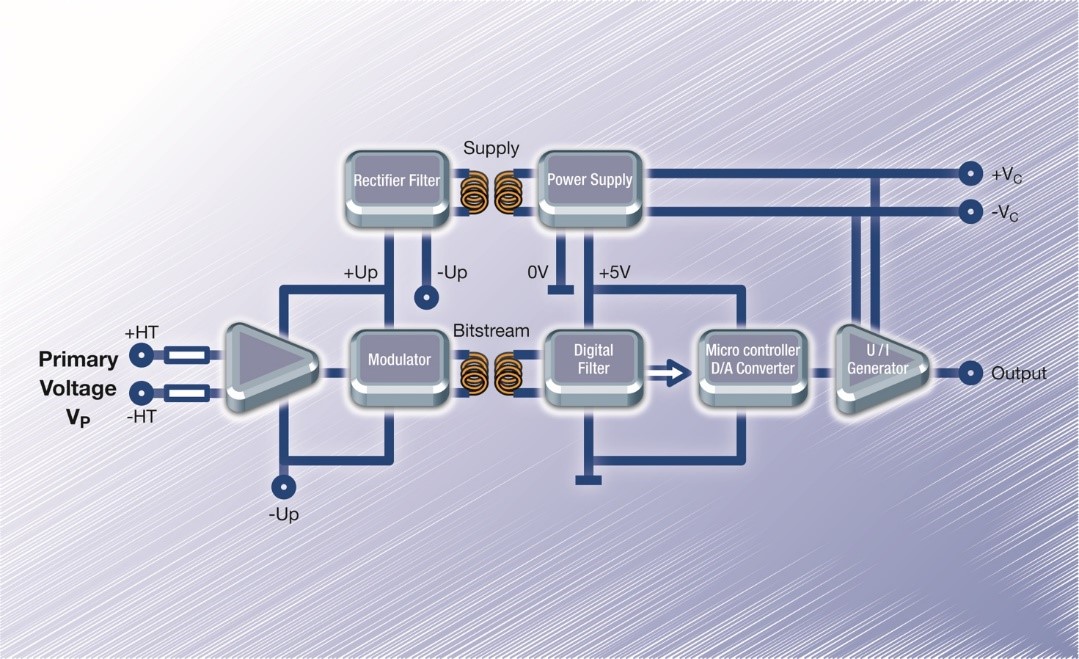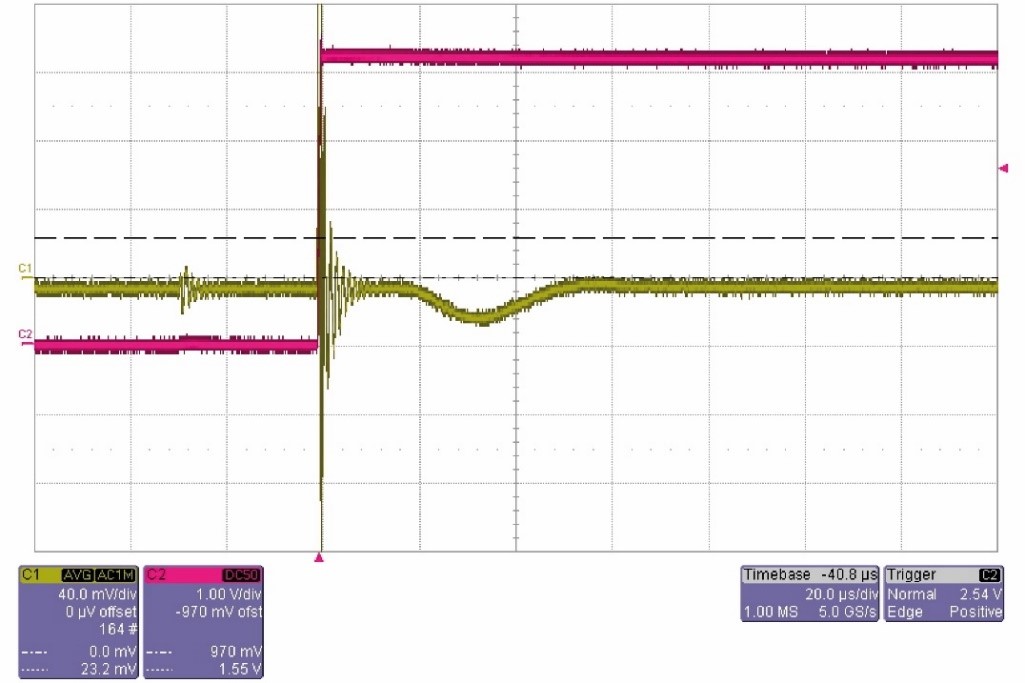Introduction
A key element of the propulsion systems for both low-speed urban transportation and high-speed intercity trains is the traction converter responsible for transforming power from an overhead catenary, a third rail, or a diesel engine to drive the electric motors.
The traction converter consists of an inverter to drive the motor and a rectifier, if connected to an AC power source, or a filter if directly connected to a DC link. Connecting the two is the DC link, which requires a constant voltage, regardless of the load, in order to guarantee sustainable performance. Reliable measurement is crucial to regulating the voltage level, making the voltage transducer a key component of the DC link and the traction converter itself.

Figure 1: A traction drive system
A traction converter needs to be able to function in a range of environmental conditions (such as extreme temperatures, dryness, and humidity), putting them under a great deal of stress. The continuing evolution of power electronics, despite significant benefits, places additional constraints on converters and their components. For example, new semiconductors with higher switching frequencies allow for a more compact design and significantly improved efficiency; but they also produce higher magnetic fields and higher common-mode perturbations that can negatively impact voltage transducers.
LEM developed the DVM voltage transducer series to meet these constantly evolving and demanding conditions (Figure 2). DVM transducers have an extremely high immunity to external magnetic fields and a partial discharge level higher than the maximum DC link voltage.
DVM voltage transducers
The DVM series is able to measure nominal voltage from 600 up to 4200 VRMS. To operate, the DVM only needs to be connected to the measuring voltage, without additional resistors inserted on the primary side. It operates with a standard DC power supply range of ±13.5 V to ±26.4 V.

Figure 2: DVM voltage transducers series measures from 600 to 4200 VRMS
With a primary voltage higher than zero, the DVM consumes a maximum of 30 mA (maximum internal consumption) plus the output current (typically 50mA at nominal value), when set up with current output.
How does it work?
Figure 3 illustrates how the DVM series works, starting from the primary voltage input. Here, the voltage would typically be ±4.2 kV. A voltage divider, able to withstand high dv/dt while having low thermal drift, then reduces the supply down to just a few volts before a sigma delta modulator converts that signal from analog to digital as a 16-bit output.
A digital encoder then produces a serial signal enabling data to be transmitted via a single isolated channel, and an amplifier feeds the signal to the primary side transformer required to provide the desired galvanic isolation. The maximum product insulation test voltage is 12 kV, so the transformer needs to withstand this while also guaranteeing the lifetime of the insulation. The DVM has been specifically designed to achieve this, discharging less than 10 pC when a 5 kV voltage is applied between the primary and secondary.
On DVM’s secondary side, the bitstream is decoded and digitally filtered. Because the primary signal square wave is distorted by the transformer, a Schmitt trigger is used on the secondary side of the transformer to restore it to a square wave. This is then fed into the digital filter to decode the data bitstream into a standard digital value that can be used in by the microcontroller’s digital to analog converter. The recovered output signal is completely insulated against the primary (high voltage) and is an exact representation of the primary voltage.
The transducer can be easily adapted for different ranges by modifying the gain programmed into the microcontroller without requiring changes in the design of the transformer or the assembly of the circuit boards in the housing. The microcontroller software cancels offsets and adjusts the gain before converting the signal from digital to analog output. The microcontroller transfers data from the digital filter to a 12-bit D/A converter with a transfer time of around 6 μs. The analog output voltage is then filtered and converted into a current (±75 mA full scale) using a current generator protected against short circuits.
The microcontroller also regulates a DC/DC converter that creates internal secondary regulated supply voltages. The DVM user typically supplies ±24 V or ±15 V DC voltage, while the DC/DC converter allows supply to the sigma delta converter and the digital encoder at primary side with +/- 5 V and +/- 3.3 V. The frequency of the DC/DC converter in this this additional circuitry, shown at the top of the schematic, is provided by the microcontroller.
To the right of the microcontroller is a voltage to current converter for users who prefer current output, typically 50 mA at nominal voltage, in order to comply with electromagnetic compatibility (EMC) regulations. The lower impedance current output is less prone to interferences from external electromagnetic fields. A voltage output version of 10 V at nominal voltage is also available, as well as a 4 to 20 mA output for unipolar measurements.

Figure 3: DVM technology: Working principle of the insulating digital technology
Main characteristics
With a typical accuracy of ±0.5 percent of VPN at ambient temperature, the DVM shows very little temperature drift, resulting in a typical accuracy of only ±1 percent of VPN over its operating temperature range from -40°C to 85°C. Initial offset at 25°C is 50µA max with a maximum possible drift of ±100µA (typical) over the operating temperature range. Linearity is only ±0.1 percent.
The DVM transducer’s typical response time (defined at 90 percent of VPN) against a voltage step at VPN is 48µs (Max 60µs). As a result of this fast response time, a large bandwidth has been verified at 12 kHz at -3 dB.
Mechanical and standards
Although it offers improved levels of accuracy and temperature stability, the DVM series is 100 percent compatible in terms of functions and performance, thus greatly simplifying retrofits. The DVM series is 100 percent mechanically compatible with earlier products (LV 100 models) for the base mounting footprint, but has slight differences in the outline dimensions, such as the primary and secondary connection locations. The new design (Figure 4) means the DVM is 30 percent shorter, occupies 25 percent less overall volume and is 56 percent lighter than the LV 100.

Figure 4: DVM vs LV 100 voltage outlines
Thanks to the mechanical design and a highly focused internal electronic design on the printed circuit, this reduction in size does not compromise the DVM’s high immunity against the external surrounding perturbations or against the high voltage variations (Figure 5).
With a DVM 4000 transducer, the resulting error in common mode condition with 6 kV/us and 4200 V applied is limited to 0.5 percent of VPN and with a short recovery time of less than 50µs. For comparison, the equivalent conditions result in up to 18 percent inaccuracy and 500µs of recovery time for a LV 100 voltage transducer.

Figure 5: DVM 4000 typical common mode behavior against dv/dt of 6 kV/us (4200 V applied): Only 0.5 percent of VPN as error generated with a recovery time of less than 50µs.
As Figure 5 shows, the effect of dynamic common mode is nearly cancelled out by the transducer’s low parasitic capacitance. This is especially important with new technologies like IGBT and MOSFETs SIC that provide a higher dv/dt between primary and secondary. The differential voltage measured by the primary can float, causing perturbations in the secondary, which is generally connected to the ground for safety reasons.
Since filtering this perturbation would reduce the response time, the DVM is designed to reduce the parasitic capacitance between primary and secondary to the lowest amount possible. The previous LV 100 voltage transducers use Hall effect technology in closed loop mode and use a magnetic circuit, making them more sensitive to external magnetic fields than DVM transducers, which do not use magnetic circuits.
The DVM also allows users to easily adjust the input isolator size depending on the input voltage, and adapt the secondary side connection as needed with connectors, shielded cables or terminals (threaded studs, M4, M5, inserts, UNC, etc.).
The DVM series has been designed and tested according to the latest worldwide standards for traction and industry applications, including IEC 61800 for drive applications, IEC 62109 for solar applications, IEC 61010 for safety and EN 50155 (Railways Applications Electronic Equipment Used on Rolling Stock), ensuring overall performance for electrical, environmental and mechanical parameters in railway applications.
Special attention was paid to the DVM’s mechanical design in order to ensure a low level of partial discharge at high voltage rates. The higher the extinction partial discharge voltage (> 5kV) the better, as no discharge happens during the normal defined function. The partial discharge level is defined at 10 pC.
As voltage rises, partial disruptive discharge starts between two points, usually at the opposite potentials in any product. Maintaining the discharge levels will reduce the product insulation over the time and then eventually impede the quality of the product until it fails. These discharges happen at a level called the ignition voltage and are defined as disappearing usually when they reach a level of 10 pC when decreasing the applied voltage (extinction voltage). Usually, the extinction voltage is lower than the ignition voltage. To ensure the long life of a product, the goal is to have the extinction voltage at a higher level than the normal working voltage rate. With an extinction voltage of 5 kV, the DVM series achieves this.
Accelerated tests have been performed to estimate failure rate, including temperature cycles as well as complete characterization of the product according to standards. Due to an innovative design, linking the insulation transformer to digital technology, DVM models guarantee insulation and partial discharge levels for high-voltage applications up to 5kV peak.
Filed Under: Industrial automation




